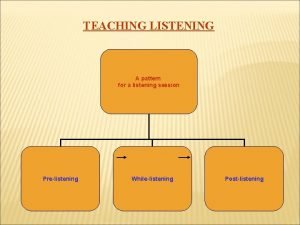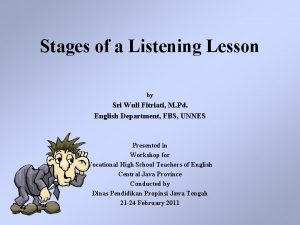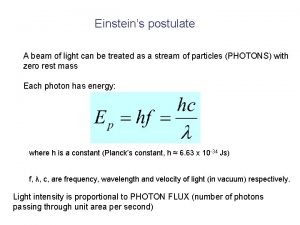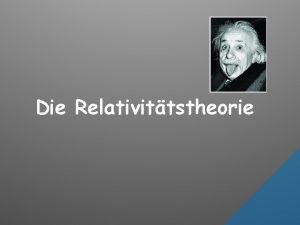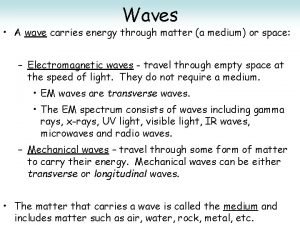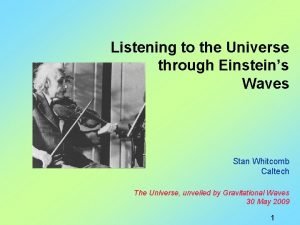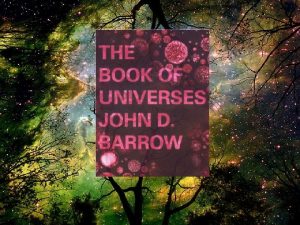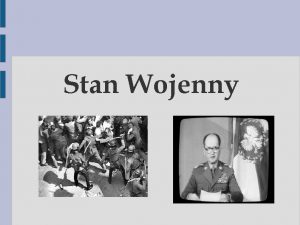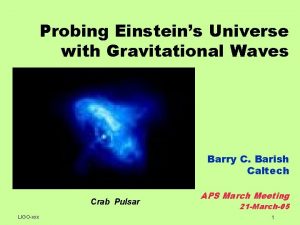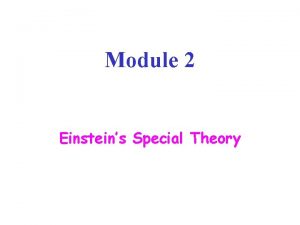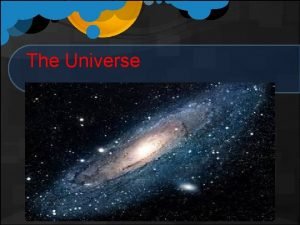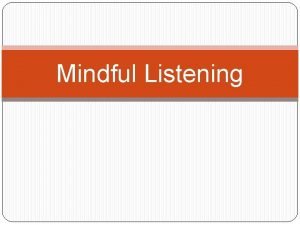Listening to the Universe through Einsteins Waves Stan

































- Slides: 33

Listening to the Universe through Einstein’s Waves Stan Whitcomb Hiro Yamamoto Caltech The Universe, unveiled by Gravitational Waves 30 May 2009 LIGO-G 0900456 -v 2 1

Newton’s Theory of Gravity (1686) LIGO-G 0900456 -v 2 2

Newton’s Theory of Gravity (1686) LIGO-G 0900456 -v 2 § Equal and opposite forces between pairs of bodies 3

Newton’s Theory of Gravity (1686) § Extremely successful theory § Solved most known problems of astronomy and terrestrial physics » eccentric orbits of comets » tides and their variations » the perturbation of the moon by gravity of the sun § Unified the work of Galileo, Copernicus and Kepler LIGO-G 0900456 -v 2 4

However, One Unexplained Fact and Two Mysteries Astronomers observed perihelion of Mercury advances by 43”/century compared to Newton’s theory What causes the mysterious force in Newton’s theory ? How can a body know the instantaneous positions of all the other bodies in the Universe? LIGO-G 0900456 -v 2 5

General Relativity A Radical Idea § Overthrew the 19 thcentury concepts of absolute space and time § Spacetime = 3 spatial dimensions + time § Perception of space and time is relative AIP Emilio Segrè Visual Archives LIGO-G 0900456 -v 2 6

General Relativity A Radical Idea § Gravity is not a force, but a property of space & time § Concentrations of mass or energy distort (warp) spacetime § Objects follow shortest path through this A B warped spacetime § Explained the precession of Mercury LIGO-G 0900456 -v 2 7

A New Prediction of Einstein’s Theory The path of light will be “bent” when it passes near a massive object (like the sun) © Royal Astronomical Society Inversely proportional to angle between sun and star Could only be seen during eclipse LIGO-G 0900456 -v 2 8

Confirming Einstein …. § Famous British astronomer Sir Arthur Eddington led an expedition to photograph the solar eclipse of 29 May 1919 against Hyades star cluster Measured Deflection © Science Museum/Science and Society Picture Library LIGO-G 0900456 -v 2 No Deflection 0 “Newtonian” 0. 87” Einstein 1. 75” Principe 1. 61” ± 0. 30” Sobral 1. 98” ± 0. 12” 9

Stunning Confirmation for Relativity London Times, 6 November 1919 LIGO-G 0900456 -v 2 Illustrated London News 22 Nov 1919 10

A New Prediction: Gravitational Waves Photograph by Yousuf Karsh of Ottawa, courtesy AIP Emilio Segre Visual Archives Ripples in spacetime moving at the speed of light LIGO-G 0900456 -v 2 11

No Evidence For T Gravitational Waves h e Until 1974 Russell A. Hulse Discovered and Studied Pulsar System PSR 1913 + 16 LIGO-G 0900456 -v 2 Source: www. NSF. gov 12 Joseph H. Taylor Jr

Neutron Binary System PSR 1913 + 16 Similar mass to our sun but only 20 km in diameter 17 / sec · · ~ 8 hr Two Neutron Stars in Orbit • Separated by 1, 000 km Prediction from General Relativity • Spiral in by 3 mm/orbit • Rate of change orbital period LIGO-G 0900456 -v 2 13

Nobel Prize No GWs Advance of Orbit (seconds) Evidence for gravitational waves! General Relativity Prediction Year LIGO-G 0900456 -v 2 14

Effect of a Passing Gravitational Wave § Imagine a circle of masses in space § Free from all disturbances, except a gravitational wave LIGO-G 0900456 -v 2 15

Effect of a Passing Gravitational Wave § Gravitational wave traveling into the picture § Change in separation (DL) proportional to initial separation (L) LIGO-G 0900456 -v 2 16

Sources of Gravitational Waves LIGO-G 0900456 -v 2 17

Requirements for Strong Gravitational Wave Sources § (Almost) all moving masses produce gravitational waves § But! § Strong waves require: Large Masses Fast motions (large accelerations) All measurable gravitational wave sources will be astronomical LIGO-G 0900456 -v 2 18

Binary Neutron Stars § Systems like the Hulse-Taylor Binary Pulsar § Losing energy as they radiate gravitational waves § Spiralling together » Slowly at first » Faster and faster as the two neutron stars move toward each other » Finally, crash together and merge LIGO-G 0900456 -v 2 19

Binary Neutron Stars § Gravitational waves tell us the story of the inspiral » Slow frequencies at first, then increasing » Slowly growing amplitude § Masses of each star, orbit, location, distance § Final stages last about 1 minute LIGO-G 0900456 -v 2 20

Black Holes § Maybe there are binary systems with two black holes instead of neutron stars » Formed from very massive binary stars? » No clear evidence of such systems § Would be very strong sources of gravitational waves § No direct way to observe black holes except through gravitational waves LIGO-G 0900456 -v 2 21

Black Hole Collisions § Black holes are one of the simplest objects in the universe yet one of the most mysterious » Completely described by three numbers Mass Spin Charge § Gravitational waves probe to the very edge of the black hole LIGO-G 0900456 -v 2 22

Supernova: One of the Most Energetic Events in our Universe 100, 000, 000 stars One supernova LIGO-G 0900456 -v 2 § Massive star (>~7 times the mass of our sun) ‘burns’ all its hydrogen § Grows to become a Red Giant as its ‘burns’ its remaining fuel § Core collapses to form neutron star § Collapsing material bounces and blows off outer regions of star § As bright as an entire galaxy for a few days 23

Gravitational Waves from a Supernova? § Visible supernova is spectacular, but it tells us little about what is causing the explosion § Rapid motion » Core collapses is very rapid (much less than 1 second) § Massive star § Meets all the criteria for strong gravitational waves Simulation: Ott 2006, Ott et al. 2007 Visualization: R. Kaehler, Zuse Institute/AEI LIGO-G 0900456 -v 2 24

Spinning Neutron Stars (Pulsars) § Neutron stars are the remnants of many supernovas § Typically 1. 4 times as massive as the sun, but only 20 km in diameter § Rapidly rotating with huge magnetic field (1 billion times stronger than any field on earth) § Produce very regular pulses of radio energy § Small “mountain” (~3 mm) or other imperfection would cause pure sinusoidal tone of gravitational waves LIGO-G 0900456 -v 2 25

‘Murmurs’ from the Big Bang signals from the early universe Cosmic microwave background LIGO-G 0900456 -v 2 26

‘Murmurs’ from the Big Bang signals from the early universe More from Professor Sato LIGO-G 0900456 -v 2 27

Detecting Gravitational Waves LIGO-G 0900456 -v 2 28

Effect of a Passing Gravitational Wave § Most important quantities to describe the wave: Strength (DL/L) Frequency LIGO-G 0900456 -v 2 29

Detecting a Gravitational Wave with Light Michelson Interferometer I have greatly exaggerated the effect!! Strength (DL/L) of a strong wave is about 10 -21 For L = 1 km, => DL = 10 -18 m LIGO-G 0900456 -v 2 30

How Small is 10 -18 Meter? One meter Human hair ~ 10 -4 m (0. 1 mm) Wavelength of light ~ 10 -6 m Atomic diameter 10 -10 m Nuclear diameter 10 -15 m GW detector 10 -18 m LIGO-G 0900456 -v 2 31

A Global Network of Gravitational Wave Interferometers LIGO GEO Virgo TAMA/LCGT • Detection confidence • Locate sources AIGO LIGO-G 0900456 -v 2 32

Looking to the Future § The existence of gravitational waves is beyond any reasonable doubt § Their detection is one of the most challenging tasks ever undertaken by scientists § They promise to give us new insights into the world of astronomy § There will be surprises! LIGO-G 0900456 -v 2 33
 Pre-listening while-listening and post-listening activities
Pre-listening while-listening and post-listening activities Pre listening while listening post listening activities
Pre listening while listening post listening activities De broglie hypothesis
De broglie hypothesis Relative geschwindigkeitsaddition
Relative geschwindigkeitsaddition Whats a reflected sound wave
Whats a reflected sound wave Mechanical waves and electromagnetic waves similarities
Mechanical waves and electromagnetic waves similarities Examples of mechanical wave
Examples of mechanical wave Constructive waves and destructive waves difference
Constructive waves and destructive waves difference Long waves and short waves
Long waves and short waves Seismic waves are mechanical waves
Seismic waves are mechanical waves Seismic waves
Seismic waves Differences between mechanical and electromagnetic waves
Differences between mechanical and electromagnetic waves Difference between matter waves and electromagnetic waves
Difference between matter waves and electromagnetic waves Do electromagnetic waves require a medium
Do electromagnetic waves require a medium Compare and contrast p waves and s waves using venn diagram
Compare and contrast p waves and s waves using venn diagram Characteristics of a longitudinal wave
Characteristics of a longitudinal wave Mechanical waves vs electromagnetic waves
Mechanical waves vs electromagnetic waves Sound waves are mechanical waves true or false
Sound waves are mechanical waves true or false Electromagnetic and mechanical waves
Electromagnetic and mechanical waves Active vs passive listening
Active vs passive listening What does critical listening mean
What does critical listening mean A wave carries
A wave carries Nissim ezekiel poem night of the scorpion
Nissim ezekiel poem night of the scorpion Through one man
Through one man Through and through furcation
Through and through furcation Advantages of timber conversion
Advantages of timber conversion Mật thư tọa độ 5x5
Mật thư tọa độ 5x5 Bổ thể
Bổ thể Chụp phim tư thế worms-breton
Chụp phim tư thế worms-breton Tư thế ngồi viết
Tư thế ngồi viết ưu thế lai là gì
ưu thế lai là gì Thẻ vin
Thẻ vin Thể thơ truyền thống
Thể thơ truyền thống Bàn tay mà dây bẩn
Bàn tay mà dây bẩn
